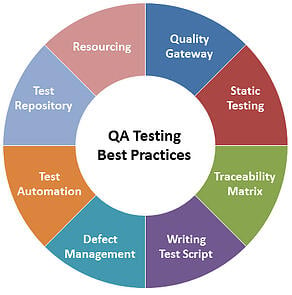Over the years, financial systems and networks enabling banks’ business operations have grown in scope, scale and complexity. To manage internal processes such as customer acquisition, existing customer management and collections processes ; and risk strategies such as ‘Authorization, CLI / CLD, Payment Hold’ etc., the banks have adopted newer enterprise grade platforms such as Visionplus (First Data), TS2 (TSYS), TRIAD (FICO), Blaze Advisor (FICO) and Strategy Design Studio (Experian).
These platforms need the system risk to be managed through a robust risk management and testing program. However, we believe, the testing practices adopted by banks have not reached the required levels of maturity. In fact, inadequate or sub-optimal testing is one of the key reasons why many enterprise grade platforms and risk strategies fail.
We believe there are the following eight practices that can really make the testing initiatives in a bank far more effective:

Quality Gateway: We have seen in large projects, there is significant misalignment among Business, Design, Development, Testing and Deployment teams, causing serious delivery quality and timeliness issues. This problem is addressed through, what we call as Quality Gateway. It is a process by which all teams come together systematically at the beginning of the project and have regular, structured meetings to discuss the requirements, issues and suggestions.
Static Testing: The concept of static testing is very simple – ‘Catch the defect early’. Static testing is leveraged to identify the defect early e.g. deviation from standards, missing requirements, design defects, non-maintainable code and inconsistent interface specifications.
Traceability Matrix: To prevent leakage of requirements to be tested, the unique requirements highlighted in Business Requirements Document (BRD) are mapped with unique test cases in the test plan in the form of a matrix.
Writing Test Scripts: Incomplete or irrelevant test scripts consume lots of efforts in execution and this causes delay in the projects. Writing test scripts is an art in itself, test scripts should be written with an investigative mindset to find the bugs / defects in the product. Test scripts should be mapped to Traceability Matrix focusing on a particular functionality.
Defect Management: Once the testing starts, it is like a ‘downpour’! In the project execution process, it becomes imperative to manage defects tightly through precise defect reporting, easy defect tracking & detailed (post-facto) defect analysis. Post each project completion; testers should analyze the rejected defects and their reasons.
Test Automation: Our experience has been that the automation adds a lot of value when there is large number of test cases and the cost of automation is not significantly high. Automation is not just for executing test scripts but is also used for stages before & after the test script execution (e.g. Macros for data conditioning, execution and evidence capturing; or automated test reporting in excel spreadsheet if not using testing tools like QC, JIRA).
Test Repository: One of the most under-rated practices is adequate documentation - pre, during and post - the testing initiatives. Not only should there be regular testing artifacts such as Test Plan, Test Scripts, Defect Logs but also diligent documentation of all the learning from the project (during and post facto).
Resourcing: Optimal execution of testing programs is not just about putting a handful of ‘testers’ to execute the test scripts. Nothing can be farther from truth. Our belief is, for successful execution, we should have Functional experts, Technical experts, Testing experts & Test Management, working on the delivery.
Adopting these practices can help achieve high levels of efficiency on all important dimensions viz. execution time, costs, resourcing and quality of delivery. In our experience, these can result in upto 30% improvement in the testing quality and yield.
Click here to get the Whitepaper





































